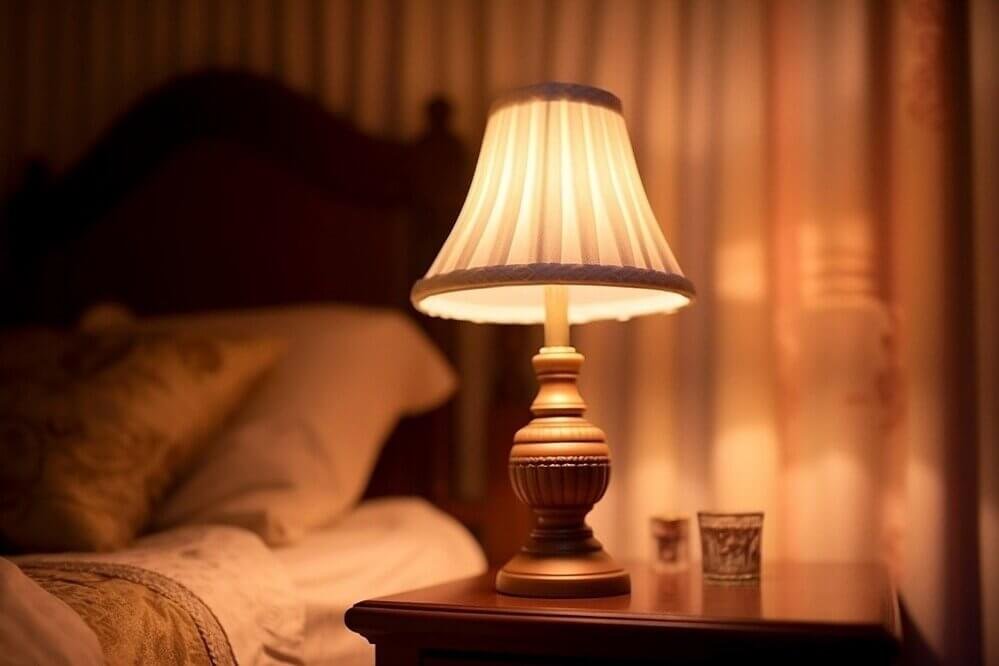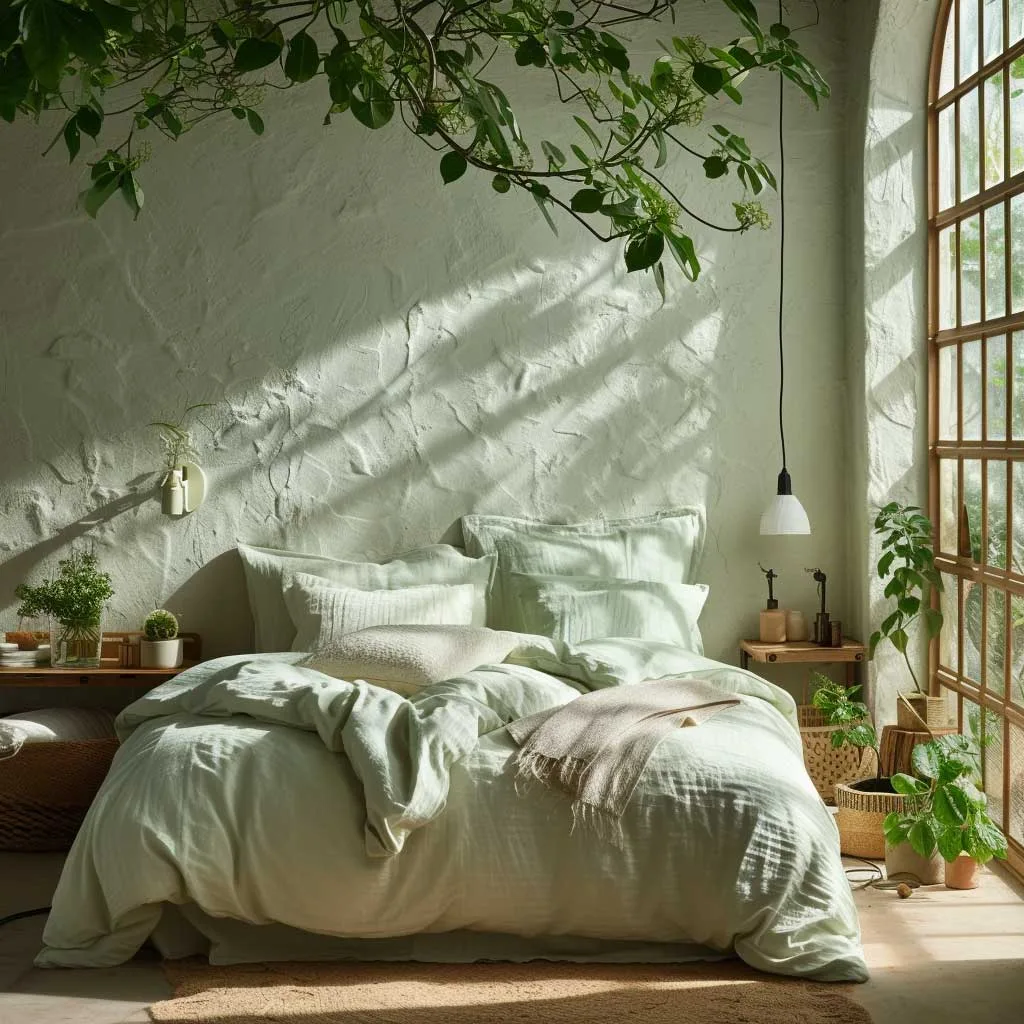Getting a good night’s rest is essential for physical and mental well-being. While selecting a high-quality mattress is a critical first step, many other aspects of your bedroom environment can impact how well (or poorly) you sleep and contribute to achieving the best sleep.
Every element can make a difference, from strategic lighting choices to thoughtful décor and layout adjustments. This guide will explore practical tips for creating a Bedroom for Better Sleep, more restorative sleep.
Table of Contents
Optimize Lighting for Relaxation
Embrace Soft, Warm Lighting
Harsh or overly bright lighting can trick your brain into staying alert, making it harder to unwind. Instead, opt for soft, warm-toned bulbs (around 2,700K–3,000K color temperature) in lamps or overhead fixtures. This softer light mimics the glow of sunset, signaling your body it’s time to wind down.

Layer Your Lighting
Consider layering your lighting sources:
- Ambient Lighting: Overhead or wall sconces that fill the room.
- Task Lighting: A reading lamp on your nightstand or a desk lamp if you have a workspace in your bedroom.Night Lights: Install night lights in bathrooms to enhance safety during nighttime movements and improve the sleep quality of families and guests.
- Accent Lighting: Soft LED strips behind a headboard or under furniture for a subtle, relaxing glow.
Minimize Blue Light in the Evening
Blue light from electronics (smartphones, tablets, TVs) can disrupt your circadian rhythm. Use night mode settings on devices, or swap your late-night screen time for reading a book under gentle, warm light.
Choose Calming Décor and Colors
Cool and Neutral Tones
Colors like light blues, soft grays, and pastels create a soothing atmosphere conducive to sleep. These palettes are less stimulating than vibrant shades like red or bright orange.
Minimalistic and Clutter-Free
Maintaining a clutter-free environment can improve the quality of sleep. Clutter can lead to mental restlessness, making it harder to relax.
Keep surfaces like nightstands and dressers free of unnecessary items. Use hidden storage solutions (under-bed drawers, built-in shelves) to maintain a sleek, tranquil look if space allows.
Add Nature-Inspired Elements to Promote Sleep
A touch of nature can have a calming effect:

- Indoor Plants: Low-maintenance options like snake plants or peace lilies also help purify the air.
- Natural Textures: Wood, bamboo, or rattan accents bring warmth and an organic feel.
Incorporating nature-inspired elements, such as essential oils like lavender and cool color tones, can promote sleep by creating a relaxing environment.
Perfect Your Layout for Better Flow
Position Your Bed Strategically
Place your bed where you can see the door while lying down (it creates a sense of security), but avoid aligning it directly with the door if possible.
This layout can help you feel calmer and more in control of your space, making it easier to fall asleep quickly.
Ensure Smooth Movement
Leave clear pathways around the bed and furniture to prevent obstacles from disrupting the room’s energy flow. A cramped layout can make the bedroom chaotic, undermining your desired relaxing vibe. Consider rearranging furniture to maximize space and create an open, inviting atmosphere.
Balance Furniture Proportions
Choose furniture pieces that fit the room’s scale. Oversized dressers or an enormous headboard in a small room can make the space feel claustrophobic, while tiny furniture in a large room can look sparse and unsettling. Consider using multi-functional furniture to maximize space efficiency and maintain a balanced aesthetic.
Focus on Bedding and Textiles
High-Quality Mattress & Pillows
Your mattress remains the foundation of good sleep. At Sinyor Yatak, we offer a range of ergonomic and orthopedic mattresses tailored to various comfort needs.
Choosing the right mattress can significantly improve sleep quality, and pairing it with the right pillow can further enhance spinal alignment and reduce neck or shoulder tension.
Comfortable Sheets and Covers

Natural fibers like cotton, linen, or bamboo allow better airflow and help regulate body temperature, essential for staying cozy without overheating.
These qualities can significantly enhance sleep quality by creating a more comfortable and restful environment.
Layering for All Seasons
Use layers, such as light quilts and throws, to adapt your bedding to changing temperatures. This approach is more flexible than relying on a single, heavy duvet year-round. Spending just a few minutes adjusting layers can enhance comfort.
Enhance Sensory Experience for Sleep
A well-designed bedroom environment can significantly impact the quality of your sleep. In addition to creating a relaxing ambiance, it’s essential to consider the sensory experiences that can promote or disrupt sleep.
In this section, we’ll explore how to enhance the sensory experience for sleep, focusing on soothing scents, blocking bothersome sounds, optimizing temperature and air quality, and incorporating calming colors.
Soothing Scents for Relaxation
Certain scents can profoundly impact our mood and ability to fall asleep. Soothing scents like lavender, vanilla, and jasmine can promote relaxation and reduce stress levels, making it easier to fall asleep.

Use essential oils or scented candles to create a calming atmosphere in your bedroom. A diffuser can also release a gentle, soothing scent.
- Lavender Oil: Known for its calming properties, it can help reduce anxiety and promote relaxation.
- Vanilla Oil: Vanilla oil has a soothing, sweet scent that can help reduce stress and promote a sense of calm.
- Jasmine Oil: Jasmine oil has a calming, floral scent that can help promote relaxation and reduce anxiety.
Block Bothersome Sounds
Bothersome sounds can significantly disrupt sleep, making falling or staying asleep difficult. Use earplugs, white noise machines, or soundproofing materials to block out distracting sounds.
You can also use a fan or a sound machine to create a constant, soothing sound that can help mask other noises.
- Earplugs: Earplugs can effectively block out distracting sounds, especially in a noisy area.
- White Noise Machines: White noise machines can create a constant, soothing sound that can help mask other noises.
- Soundproofing Materials: Soundproofing materials like acoustic panels or sound-absorbing curtains can help reduce echo and block out distracting sounds.
Optimize Temperature and Air Quality
A comfortable temperature and good air quality are essential for a restful sleep. In this section, we’ll explore how to optimize temperature and air quality in your bedroom.
Cool it Off
A cooler bedroom temperature can promote better sleep. Consider using a fan or a cooling pad to keep your bedroom comfortable.
You can also use light, breathable bedding to help regulate your body temperature.
- Ideal Temperature: The ideal bedroom temperature is between 60-67°F (15-19°C).
- Cooling Methods: Consider using a fan, a cooling pad, or light, breathable bedding to keep your bedroom cool.
- Bedding: Choose light, breathable bedding to help regulate your body temperature.
By enhancing the sensory experience for sleep, optimizing temperature and air quality, and creating a relaxing ambiance, you can improve the quality of your sleep and wake up feeling rested and refreshed.
Contact us today and get the best offer!
Additional Tips for a Sleep-Friendly Environment
Sound Control
Use heavy curtains or soundproofing panels if you live in a noisy area. A white-noise machine or fan can also mask disruptive sounds. Additionally, consider adding rugs or carpets to help absorb sound and create a quieter environment. Incorporating these elements can significantly enhance the tranquility of your bedroom, promoting better sleep quality.
Temperature Regulation
Keep the bedroom around 18-20°C (65-68°F) for optimal sleep. Use curtains or blinds to block intense sunlight in summer and retain warmth during colder months. Additionally, consider using a programmable thermostat to maintain consistent temperatures throughout the night.
Scent and Aromatherapy
Infuse the room with calming scents like lavender or chamomile. Essential oil diffusers or linen sprays can elevate the relaxing ambiance, making it easier to unwind and fall asleep peacefully.
Keep Electronics Away
Avoid TVs or workstations in the bedroom to maintain a clear boundary between sleep and other activities. If you must have a TV, hide it in a cabinet or use a screen cover when not in use. This helps create a dedicated space for relaxation and restful
Use Sleep Masks
Consider using sleep masks to block out light and improve sleep quality. Sleep masks infused with lavender can promote relaxation while enhancing the sleep experience. Additionally, they can be a stylish and convenient way to ensure a restful night’s sleep, even during the day.
Conclusion
Creating a sleep-friendly bedroom goes beyond picking the right mattress—it’s about harmonizing every element, from lighting to décor.
Focusing on warm-toned lights, clutter-free design, thoughtful furniture placement, and quality bedding can transform your bedroom into a cozy retreat that promotes deep, uninterrupted rest.
Whether upgrading your mattress, seeking high-quality pillows, or needing expert advice on mattress care, Sinyor Yatak is here to guide you. Visit our showroom or contact us today to learn how our range of bedding solutions can complement your newly rejuvenated sleep sanctuary.
reed a mor of articles: Mattress Shopping Mistakes to Avoid: The Ultimate Buyer’s Guide – Charming decor and soothing colors
Frequently Asked Questions
How can I make my bedroom good for sleep?
To improve your bedroom, please focus on optimizing the environment. Use soft, warm lighting to signal your body to wind down and minimize blue light exposure from electronic devices. Keep the room clutter-free to reduce mental restlessness, and choose calming décor with cool and neutral tones. Ensure your bedding is comfortable and suitable for temperature regulation, and consider using a white noise machine to block out disruptive sounds.
What is the 10 3 2 1 0 rule for sleep?
The 10 3 2 1 0 rule is a guideline to improve sleep quality. It suggests:
10 hours before bed, avoid caffeine to ensure it doesn’t disrupt sleep.
3 hours before bed, avoid eating heavy meals or consuming alcohol.
2 hours before bed, stop working to allow your mind to relax.
1 hour before bed, turn off screens to reduce blue light exposure.
0 is the number of times you should hit the snooze button in the morning for better wakefulness.
Which bedroom should you sleep in?
The ideal bedroom for sleep should be a quiet, dark, and calm environment. Choose a room that is away from noise, has minimal light exposure, and maintains a comfortable temperature between 60-67°F (15-19°C). Ensure the room is well-ventilated to promote good air quality, and use blackout curtains or sleep masks to block out light for the best sleep quality.
Disclaimer: This article provides general suggestions for improving your bedroom. For specific health-related concerns or chronic sleep issues, please feel free to consult a healthcare professional.



